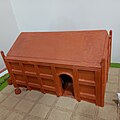Top Qs
Timeline
Chat
Perspective
Shkinta
Celestial dwelling or ritual hut in Mandaeism From Wikipedia, the free encyclopedia
Remove ads
In Mandaeism, a shkinta (Classical Mandaic: ࡔࡊࡉࡍࡕࡀ, romanized: škinta, lit. 'shekinah') or shkina (škina) is a celestial dwelling inhabited by uthras in the World of Light that is analogous to the shekhinah in Jewish mysticism. In Tibil (the physical earth), it refers to a reed or mud hut that is used during Mandaean priest initiation ceremonies, since Mandaean priests represent uthras on earth.[1]


Remove ads
Ceremonial usage
During the priest initiation ceremony, the shkinta is constructed to the north of the andiruna. It symbolizes the World of Light and it covered by a white cloth roof. In contrast, the andiruna has a blue cloth roof to symbolize the color of Ruha. Together, the two adjacent huts symbolize complementary masculine and feminine elements.[2]
Symbolism
The škinta (cognate with the Hebrew word shekhinah; from the Semitic root š-k-n, associated with dwellings) symbolizes the "male" side, and is associated with the World of Light, priests, the right side, gold, and the taga (crown).[2]
In contrast, the andiruna symbolizes the "female" side, and is associated with the earth (Tibil), laypeople, the left side, silver, and the klila (myrtle wreath).[2] Similarly, in a traditional Persian house, the women's quarters are known as andirūn.[1]
Remove ads
In artwork
In 2018, Mandaean-Australian priest and artist Yuhana Nashmi created Sh-ken-ta, an exhibition of a shkinta, as a site-specific installation at the Casula Powerhouse Arts Centre.[3][4]
Gallery
- A reed house in the marshes of Basra Province, southern Iraq in 1978. The shkinta is based on such reed structures.
- Miniature model of a shkinta displayed at Ganzibra Dakhil Mandi in Liverpool, New South Wales, Australia
- Miniature model of a shkinta displayed at Ganzibra Dakhil Mandi in Liverpool, New South Wales, Australia
- Miniature model of a shkinta displayed at Ganzibra Dakhil Mandi in Liverpool, New South Wales, Australia
- Shkinta located adjacent to Wallacia Mandi in Wallacia, New South Wales, Australia
- Shkinta located inside Yahya Yuhana Mandi in Prestons, New South Wales, Australia
Remove ads
See also
- Andiruna
- Shekhinah
- Sweat lodge in Native American spiritual ceremonies
- Tarmida
- Anana (Mandaeism)
References
External links
Wikiwand - on
Seamless Wikipedia browsing. On steroids.
Remove ads






